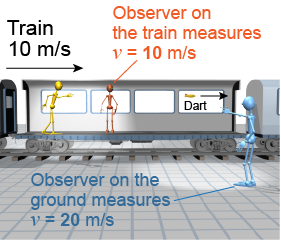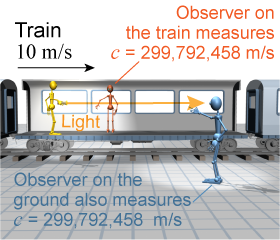|
Nearly everyone has heard of relativity, but not many people know what it means. There are two different forms of relativity, both proposed by Albert Einstein. The theory of special relativity connects velocity, time, and space. The theory of general relativity presents a totally different way to understand gravity. Both theories may seem like science fiction, but they are well tested and part of the technology you use every day. GPS satellites incorporate general relativity, and virtually all optical fiber data networks must take account of special relativity. 
|

|
The speed of light, c = 299,792,458 m/s, is the fastest speed in our universe. Around 1900, Einstein asked himself what light would look like if he could see it when it wasn’t moving. Instead of making the light stop, Einstein thought about traveling beside light at the same speed. You may have driven next to someone going the same speed on the highway. When you look out the window, the other car seems motionless relative to you. Einstein thought about whether it might be possible to travel at the same speed as light and about how light would appear if you could. 
|
 Recall the dart thrown on a train from earlier in this chapter. If the person throws the dart at 10 m/s relative to the train, and the train is approaching you at 10 m/s, the dart gets 20 m closer to you every second. As far as you are concerned, you see the dart traveling 20 m/s toward you. The speed of the dart in your reference frame is the speed in its reference frame (the train) plus the speed of that reference frame with respect to you.
Recall the dart thrown on a train from earlier in this chapter. If the person throws the dart at 10 m/s relative to the train, and the train is approaching you at 10 m/s, the dart gets 20 m closer to you every second. As far as you are concerned, you see the dart traveling 20 m/s toward you. The speed of the dart in your reference frame is the speed in its reference frame (the train) plus the speed of that reference frame with respect to you. 
|
 Einstein considered what the speed of light would be if the person on the train shined a flashlight at you as in the case of the thrown dart. Physicists at that time believed that the ground observer should measure a speed equal to the speed of light in the train’s moving reference frame plus the speed of the train. But that is not what happens. The speed of light is 299,792,458 m/s for both observers no matter the speed of the train or its direction, forward or backward!
Einstein considered what the speed of light would be if the person on the train shined a flashlight at you as in the case of the thrown dart. Physicists at that time believed that the ground observer should measure a speed equal to the speed of light in the train’s moving reference frame plus the speed of the train. But that is not what happens. The speed of light is 299,792,458 m/s for both observers no matter the speed of the train or its direction, forward or backward! 
|
In 1887, Albert A. Michelson and Edward W. Morley wanted to determine whether the speed of light changed as a result of the Earth’s motion. Michelson and Morley made sensitive measurements of the speed of light both parallel and perpendicular to the orbital motion of the Earth. In effect, they used the Earth as a “train” moving at 29,800 m/s—Earth’s orbital speed. They found the speed of light to be exactly the same for both directions! This result is not at all what they expected. How could it be explained? 
 |
Michelson and Morley conducted their first experiment in 1887, and Einstein published his paper on the theory of special relativity in 1905. It would seem obvious from this timeline that Einstein developed his theory in response to the experimental results of Michelson and Morley. Historians, however, debate the extent to which Einstein was influenced by the earlier work. Nonetheless, it appears likely that the well-known experimental results helped Einstein’s theory gain acceptance more readily by the scientific community. 
|
| |
|

